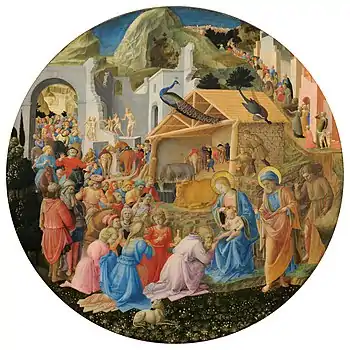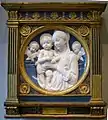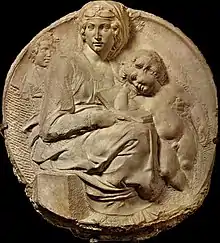Tondo (art)
A tondo (plural "tondi" or "tondos") is a Renaissance term for a circular work of art, either a painting or a sculpture. The word derives from the Italian rotondo, "round." The term is usually not used in English for small round paintings, but only those over about 60 cm (two feet) in diameter, thus excluding many round portrait miniatures – for sculpture the threshold is rather lower.

A circular or oval relief sculpture is also called a roundel.[1] The infrequently-encountered synonym rondo[2] usually refers to the musical form.
History
Artists have created tondi since Greek antiquity. The circular paintings in the centre of painted vases of that period are known as tondi, and the inside of the broad low winecup called a kylix also lent itself to circular enframed compositions.[3] Although the earliest true Renaissance, or late Gothic painted tondo is Burgundian, from Champmol (of a Pietá by Jean Malouel of 1400–1415, now in the Louvre), the tondo became fashionable in 15th-century Florence, revived as a classical form especially in architecture. It may also have developed from the smaller desco da parto or birthing tray. The Desco da parto by Masaccio from around 1423 may be one of the first to use linear perspective, another feature of the Renaissance. Also using linear perspective was Donatello for the stucco tondi created around 1435–1440 for the Sagrestia Vecchia at the Basilica of San Lorenzo designed by Brunelleschi, one of the most prominent buildings of the Early Renaissance. For Brunelleschi's Hospital of the Innocents already (1421–24), Andrea della Robbia provided glazed terracotta babes in swaddling clothes in tondos with plain blue backgrounds to be set in the spandrels of the arches. Andrea and Luca della Robbia created glazed terracotta tondi that were often framed in a wreath of fruit and leaves, which were intended for immuring in a stuccoed wall. Filippo Lippi's Bartolini Tondo (1452-1453) was one of the earliest examples of such paintings.
In painting Botticelli created many examples, both Madonnas and narrative scenes,[4] and Michelangelo employed the circular tondo for several compositions, both painted and sculpted, including the Doni Tondo at the Uffizi, as did Raphael.
In the sixteenth century the painterly style of istoriato decoration for maiolica wares was applied to large circular dishes (see also charger). Since then it has been less common. In Ford Madox Brown's painting The Last of England, the ship's wire railing curving round the figures helps enclose the composition within its tondo shape.
Examples
 Portrait of family of Septimius Severus, so-called Severan Tondo, Roman painting of c. 200 AD, Altes Museum, Berlin
Portrait of family of Septimius Severus, so-called Severan Tondo, Roman painting of c. 200 AD, Altes Museum, Berlin Andrea della Robbia, Madonna and Child with Cherubin, 1485
Andrea della Robbia, Madonna and Child with Cherubin, 1485.png.webp) Sandro Botticelli, Madonna of the Pomegranate, c. 1487, tempera on panel, 143.5 cm diameter, Uffizi, Florence
Sandro Botticelli, Madonna of the Pomegranate, c. 1487, tempera on panel, 143.5 cm diameter, Uffizi, Florence Michelangelo, Pitti Tondo, c. 1504–05, Uffizi
Michelangelo, Pitti Tondo, c. 1504–05, Uffizi
 Michelangelo, Doni Tondo, c. 1507, Uffizi
Michelangelo, Doni Tondo, c. 1507, Uffizi
See also
- Medallion (architecture): round or oval
- Cartouche (design): oval
- Panel painting: normally rectangular or capsule-shaped
References
- Wyke, Terry; Cocks, Harry (2004). Public Sculpture of Greater Manchester. Liverpool University. p. 434. ISBN 978-0-85323-567-5.
roundel: circular or oval frame within which a relief sculpture may be situated
- Artlex.com Archived 2005-04-24 at the Wayback Machine.
- E. F. van der Grinten, On the Composition of the Medallions in the Interiors of Greek Black- and Red-Figured Kylixes. Amsterdam 1966
- For example The Adoration of the Kings, a tondo from about 1470-5 at the National Gallery in London.
Further reading
- Roberta J. M. Olson, The Florentine Tondo, Oxford 2000.
- Moritz Hauptmann, Der Tondo: Ursprung, Bedeutung und Geschichte des italienischen Rundbildes in Relief und Malerei, Frankfurt am Main 1936.